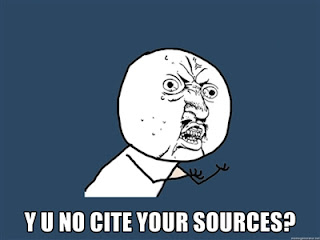As some of you will have picked up, among other things I am a teacher, and each year I teach a four week unit to year 9s (14 year olds) on family history. This year it just happened to coincide with National Family History Month, which was pretty good timing! Although it's slightly off topic in that it's not pertaining to my family, I thought some readers might be interested in hearing about the experience of working with the really young'uns on their genealogy, and how I've come to be probably the only teacher in the southern hemisphere who refers to Elizabeth Shown Mills in class!
Anything to get them to stop talking about this guy!
The kids undertake this as part of a compulsory unit, so there's a whole range of abilities and motivation levels on the go each year.
1) Preparing the kids
Being a
2) Now for the 'story'
As people who write about engaging newbies in genealogy always identify, everyone loves to think that their family will have some great stories. It's at this point I show one (or two, time permitting) episodes of WDYTYA, to show the kids how they can use records to discover a story. Sometimes I use the Paul Mercurio episode, sometimes the Shaun Micallef one, depending on my class. If I get a boys' class I'd consider doing Ron Barassi or Michael O'Loughlin. I think one thing that show almost always shows really clearly is the connection between interviewing relatives, finding records, and developing the family narrative, then sharing it with others, which is what I want the kids to do.
3) "Sources" is not a dirty word
This is when I introduce the concept of sources. The kids are used to locating sources, evaluating them and referencing them, so there's a base level of understanding in place already. What they aren't used to is the range of things which constitute a source in family history, how to reference such diverse sources, and the importance of doing so even for a personal history. I show them a PowerPoint containing categories of sources, pictures of examples from my own family tree (we have quite a bit of fun with that!), how each is referenced (go EE!) and then we have a discussion about problematic sources, again with some examples from my own tree. It's about this point that we also talk about avoiding common research mistakes.
4) Time to go and apply!
The kids embark on their two week research phase while we do other classwork. When we revisit the topic, they have their sources collected. It's a special moment. Kids come in with scans of gorgeous old photos, photocopied letters and an abundance of stories which are new to them. They are always itching to share what they found with each other. We work on preparing our pedigree charts, timelines, source evaluations and a report on an area of interest which emerged in their research. Sometimes that's one branch of the family, sometimes it's an individual, sometimes it's a couple and sometimes it's a particular family unit. I assist with brick walls if anyone has identified one they are particularly keen to break down.
Like all other History assignments, there are no marks for 'pretty', only conforming to presentation conventions (eg how to structure a report, using capital letters for surnames in a pedigree chart etc.) However, the kids almost all spend hours making elaborate display folders full of their findings, because they all know by this point of the task that this is one assignment which is not going into the bin once it's marked or even at the end of the year. They all report having a great time and being fascinated by some of the stories they discovered existed in their own families. We revisit our research skills in Term Four when we apply them to finding out about a local World War 1 serviceman.
I got into genealogy because of a basic family tree I was asked to complete in year 8. I really hope that in 20 years time, at least a few of those kids are blogging a similar story to mine about how a school assignment lead to a lifelong interest in researching their family history.
No pics today, for obvious reasons, so here's a meme instead!


What fun that unit of work would be.
ReplyDeleteThe kids consistently rate it as their top unit for the semester on the end of year evaluations, and I often get parent emails saying how much the whole family has enjoyed or gained from the assignment. It's great!
ReplyDelete